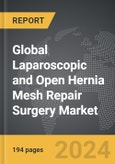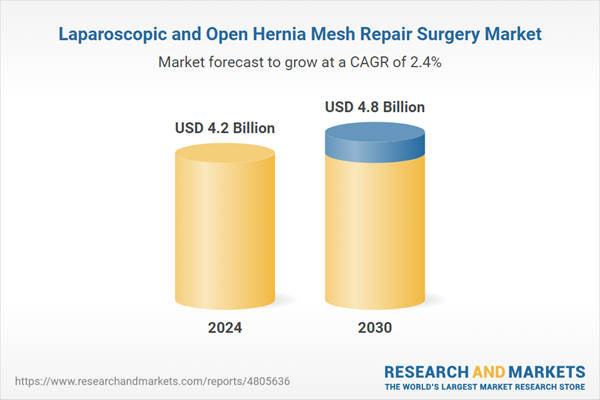The global market for Laparoscopic and Open Hernia Mesh Repair Surgery was valued at US$4.2 Billion in 2024 and is projected to reach US$4.8 Billion by 2030, growing at a CAGR of 2.4% from 2024 to 2030. This comprehensive report provides an in-depth analysis of market trends, drivers, and forecasts, helping you make informed business decisions. The report includes the most recent global tariff developments and how they impact the Laparoscopic and Open Hernia Mesh Repair Surgery market.
Segments: Hernia Mesh Fixation (Tack Applicators, Glue Applicators); Surgery Type (Open Hernia Repair, Laparoscopic Hernia Repair).
Geographic Regions/Countries: World; United States; Canada; Japan; China; Europe (France; Germany; Italy; United Kingdom; and Rest of Europe); Asia-Pacific; Rest of World.
The analysts continuously track trade developments worldwide, drawing insights from leading global economists and over 200 industry and policy institutions, including think tanks, trade organizations, and national economic advisory bodies. This intelligence is integrated into forecasting models to provide timely, data-driven analysis of emerging risks and opportunities.
Global Laparoscopic and Open Hernia Mesh Repair Surgery Market - Key Trends & Drivers Summarized
Why Are Laparoscopic and Open Hernia Mesh Repair Surgeries Gaining Popularity?
Laparoscopic and open hernia mesh repair surgeries are gaining popularity due to their effectiveness in reducing recurrence rates and improving patient outcomes. Hernia mesh repair, which involves placing a mesh over or under the weakened area to support the abdominal wall, has become the gold standard for treating hernias. Laparoscopic surgery, in particular, offers benefits such as smaller incisions, faster recovery times, and reduced postoperative pain, making it a preferred choice for both patients and surgeons. Open hernia repair, while more invasive, remains an important option for complex cases or when laparoscopic methods are not feasible. As the prevalence of hernias continues to rise, particularly in aging populations, the demand for hernia mesh repair surgeries is increasing, driving growth in this market.How Are Technological Innovations Shaping the Hernia Mesh Repair Surgery Market?
Technological innovations are significantly shaping the hernia mesh repair surgery market by enhancing surgical techniques, improving mesh materials, and offering better postoperative outcomes. Advances in minimally invasive surgical tools, such as 3D imaging and robotic-assisted surgery, are making laparoscopic hernia repair more precise and accessible. These technologies allow surgeons to perform complex procedures with greater accuracy and reduced trauma to surrounding tissues. Additionally, the development of advanced mesh materials, such as lightweight, absorbable, and anti-adhesive meshes, is improving patient comfort and reducing the risk of complications, such as infection or chronic pain. These innovations are not only improving the effectiveness of hernia repair surgeries but also expanding the range of patients who can benefit from these procedures.What Challenges Are Present in the Hernia Mesh Repair Surgery Market?
The hernia mesh repair surgery market faces several challenges, including concerns over mesh-related complications, the high cost of advanced surgical techniques, and the need for specialized training. Despite the benefits of mesh repair, there have been reports of complications such as mesh migration, infection, and chronic pain, which have led to lawsuits and increased scrutiny of mesh products. These concerns have made some patients and surgeons cautious about using mesh, particularly in cases where non-mesh repairs might be viable. Additionally, the cost of advanced laparoscopic equipment and materials can be prohibitive, particularly in developing regions where healthcare budgets are constrained. The complexity of laparoscopic surgery also requires specialized training and experience, limiting the availability of these procedures in some areas. To address these challenges, the industry is focusing on improving mesh safety, reducing costs through innovation, and expanding training programs for surgeons.What Factors Are Driving Growth in the Hernia Mesh Repair Surgery Market?
The growth in the laparoscopic and open hernia mesh repair surgery market is driven by several factors, including the increasing prevalence of hernias, advancements in surgical techniques, and the development of safer, more effective mesh products. As the global population ages and obesity rates rise, the incidence of hernias is expected to increase, leading to greater demand for repair surgeries. Advancements in minimally invasive techniques, such as robotic-assisted surgery, are making laparoscopic hernia repair more accessible and appealing to both patients and healthcare providers. Additionally, ongoing improvements in mesh design and materials are enhancing the safety and effectiveness of hernia repairs, reducing the risk of complications and improving long-term outcomes. As these trends continue, the market for hernia mesh repair surgery is expected to experience sustained growth, driven by the need for reliable, effective, and minimally invasive treatment options.Report Scope
The report analyzes the Laparoscopic and Open Hernia Mesh Repair Surgery market, presented in terms of units. The analysis covers the key segments and geographic regions outlined below.Segments: Hernia Mesh Fixation (Tack Applicators, Glue Applicators); Surgery Type (Open Hernia Repair, Laparoscopic Hernia Repair).
Geographic Regions/Countries: World; United States; Canada; Japan; China; Europe (France; Germany; Italy; United Kingdom; and Rest of Europe); Asia-Pacific; Rest of World.
Key Insights:
- Market Growth: Understand the significant growth trajectory of the Tack Applicators segment, which is expected to reach US$3.7 Billion by 2030 with a CAGR of a 2.5%. The Glue Applicators segment is also set to grow at 2.1% CAGR over the analysis period.
- Regional Analysis: Gain insights into the U.S. market, valued at $1.1 Billion in 2024, and China, forecasted to grow at an impressive 2.0% CAGR to reach $752.6 Million by 2030. Discover growth trends in other key regions, including Japan, Canada, Germany, and the Asia-Pacific.
Why You Should Buy This Report:
- Detailed Market Analysis: Access a thorough analysis of the Global Laparoscopic and Open Hernia Mesh Repair Surgery Market, covering all major geographic regions and market segments.
- Competitive Insights: Get an overview of the competitive landscape, including the market presence of major players across different geographies.
- Future Trends and Drivers: Understand the key trends and drivers shaping the future of the Global Laparoscopic and Open Hernia Mesh Repair Surgery Market.
- Actionable Insights: Benefit from actionable insights that can help you identify new revenue opportunities and make strategic business decisions.
Key Questions Answered:
- How is the Global Laparoscopic and Open Hernia Mesh Repair Surgery Market expected to evolve by 2030?
- What are the main drivers and restraints affecting the market?
- Which market segments will grow the most over the forecast period?
- How will market shares for different regions and segments change by 2030?
- Who are the leading players in the market, and what are their prospects?
Report Features:
- Comprehensive Market Data: Independent analysis of annual sales and market forecasts in US$ Million from 2024 to 2030.
- In-Depth Regional Analysis: Detailed insights into key markets, including the U.S., China, Japan, Canada, Europe, Asia-Pacific, Latin America, Middle East, and Africa.
- Company Profiles: Coverage of players such as B. Braun Melsungen AG, Baxter International, Inc., Baylor College of Medicine, Becton, Dickinson and Company, Cook Medical, LLC and more.
- Complimentary Updates: Receive free report updates for one year to keep you informed of the latest market developments.
Some of the 41 companies featured in this Laparoscopic and Open Hernia Mesh Repair Surgery market report include:
- B. Braun Melsungen AG
- Baxter International, Inc.
- Baylor College of Medicine
- Becton, Dickinson and Company
- Cook Medical, LLC
- CooperSurgical, Inc.
- Cousin Surgery
- Grena Ltd.
- Herniamesh Srl
- Insightra Medical, Inc.
Tariff Impact Analysis: Key Insights for 2025
Global tariff negotiations across 180+ countries are reshaping supply chains, costs, and competitiveness. This report reflects the latest developments as of April 2025 and incorporates forward-looking insights into the market outlook.The analysts continuously track trade developments worldwide, drawing insights from leading global economists and over 200 industry and policy institutions, including think tanks, trade organizations, and national economic advisory bodies. This intelligence is integrated into forecasting models to provide timely, data-driven analysis of emerging risks and opportunities.
What’s Included in This Edition:
- Tariff-adjusted market forecasts by region and segment
- Analysis of cost and supply chain implications by sourcing and trade exposure
- Strategic insights into geographic shifts
Buyers receive a free July 2025 update with:
- Finalized tariff impacts and new trade agreement effects
- Updated projections reflecting global sourcing and cost shifts
- Expanded country-specific coverage across the industry
Table of Contents
I. METHODOLOGYII. EXECUTIVE SUMMARY2. FOCUS ON SELECT PLAYERSIII. MARKET ANALYSISIV. COMPETITION
1. MARKET OVERVIEW
3. MARKET TRENDS & DRIVERS
4. GLOBAL MARKET PERSPECTIVE
UNITED STATES
CANADA
JAPAN
CHINA
EUROPE
FRANCE
GERMANY
ITALY
UNITED KINGDOM
REST OF EUROPE
ASIA-PACIFIC
REST OF WORLD
Companies Mentioned (Partial List)
A selection of companies mentioned in this report includes, but is not limited to:
- B. Braun Melsungen AG
- Baxter International, Inc.
- Baylor College of Medicine
- Becton, Dickinson and Company
- Cook Medical, LLC
- CooperSurgical, Inc.
- Cousin Surgery
- Grena Ltd.
- Herniamesh Srl
- Insightra Medical, Inc.
Table Information
| Report Attribute | Details |
|---|---|
| No. of Pages | 194 |
| Published | April 2025 |
| Forecast Period | 2024 - 2030 |
| Estimated Market Value ( USD | $ 4.2 Billion |
| Forecasted Market Value ( USD | $ 4.8 Billion |
| Compound Annual Growth Rate | 2.4% |
| Regions Covered | Global |









